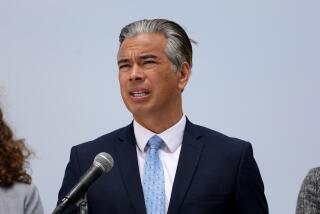Years After Spill, Pain Lingers
- Share via
ANCHORAGE — Oil that spilled when the Exxon Valdez tanker ran aground on a jagged rock in 1989 still lingers on and just below Alaska’s surface.
So does the resentment, and state hearings on the continued effects of the 11-million-gallon spill are reviving the pain and anger of the people affected by the spill.
Exxon Mobil Corp. spokesman Mark Boudreaux has said the company paid the compensation it owes and that its studies show Prince William Sound is “healthy, robust and thriving.”
But in sometimes emotional testimony, fishermen, Native American leaders, conservationists and academics said the government should seek additional damages of as much as $100 million from Exxon Mobil for unexpected effects of the spill.
“What Exxon did to us is not fair. What has been done to us is a travesty,” Robert Wolfe, a fisherman who lives in Girdwood, said at a hearing Saturday.
Dozens of people have spoken at these hearings, which state officials are holding to decide whether to file a claim for additional damages. At least two more sessions are scheduled.
Some of those who testified Saturday raged against Exxon Mobil. Some offered ideas about research and restoration projects that could be undertaken with the money. Others talked about species that haven’t recovered in Prince William Sound, such as Pacific herring.
“We’re just fishermen, but it’s a way of life and it’s been destroyed,” said Evan Beedle of Cordova.
Bill Hall, a former mayor of Cordova, said: “This for me is an experience of a lingering effect of the oil spill. It’s dragging and making it more painful and sustained over time.”
Alaska Atty. Gen. David Marquez, who is conducting the hearings, said he was struck by the emotion on display.
“One of the things, of course, we have been reminded about is the great passion that surrounds the aftermath of this horrible tragedy, and that’s important for us to hear,” Marquez said.
In a 1991 civil settlement, Exxon agreed to pay $900 million over 10 years. A “reopener” provision created a window from 2002 to 2006 in which the state and federal governments could claim as much as an additional $100 million.
That is separate from a disputed punitive-damage judgment of $4.5 billion that the company has not paid.
An assessment presented by consultant Lucinda Jacobs for the Exxon Valdez Oil Spill Trustee Council estimated that as many as six miles of the sound’s shoreline are still affected by the spill and that as much as 100 tons of Exxon Valdez oil remains in the sound. An undetermined amount lingers beyond the sound, she said.
The reopener provision expires Sept. 1, and the state and federal governments must file a claim 90 days before that date. They would have to prove that a population, habitat or species had suffered loss or decline in the area of the spill and that the loss could be linked to the spill.
More to Read
Sign up for Essential California
The most important California stories and recommendations in your inbox every morning.
You may occasionally receive promotional content from the Los Angeles Times.













